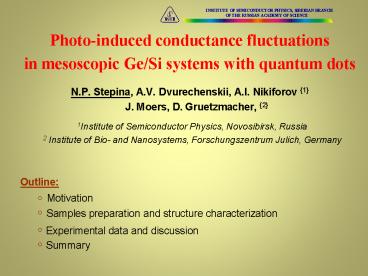Photo-induced conductance fluctuations PowerPoint PPT Presentation
1 / 17
Title: Photo-induced conductance fluctuations
1
- Photo-induced conductance fluctuations
- in mesoscopic Ge/Si systems with quantum dots
- N.P. Stepina, A.V. Dvurechenskii, A.I. Nikiforov
1 - J. Moers, D. Gruetzmacher, 2
- 1Institute of Semiconductor Physics,
Novosibirsk, Russia - 2 Institute of Bio- and Nanosystems,
Forschungszentrum Julich, Germany
2
Motivation
High density of QDs(41011cm-2) allows to
observe hopping among tunnel-coupled QDs
Strong non-monotonic dependence of VRH on number
of holes in QDs is the characteristic feature of
QD system.
(Yakimov)
To change the hole filling factor it is possible
to change the conductance of the system
3
Motivation
Photoconductance in macroscopic samples
Results -Both positive and negative photoeffect
are observed in QD samples. -Kinetics of
photoconductance is anomalously slow. -Persistant
photocondactance is observed after several hours
of relaxation.
4
Motivation
In mesoscopic samples (size smaller than LK),
there is no self-averaging among different
realization of the current paths One can observe
the physical processes corresponding to the unit
events of network transformation As conductance
depends on the particular realization of the
potential, the illumination should provoke the
conductance fluctuations
The aim of this work is to show the possibility
to observe the photo-stimulated conductance
switchings under single photon absorption in
mesoscopic structures with quantum dots.
5
The structures under study
G?Gi
R?Ri
Channel size 70-500 nm
We present the experimental results of
photo-induced conductance fluctuations in
nanometer size QDs structures with different
width and length of conductance channels under
small flux of infrared illumination.
6
Experimental setup
Source meter Keithley 6430 Electrometer
Keithley 6514 Pre-amplifier on the basis of
INA116 chip for differential measurement of
voltage GUARDING around of the signal wires for
preventing of leakage current and shunting of
parasitic capacitance.
7
Photoconductance fluctuations in mesoscopic
structures
Photoconductance kinetics for meso- (b) and
macroscopic (a) samples.
8
Motivation
Illumination with ? 1.55 ?m
Redistribution of the carriers between different
QDs inder illumination new potential landscape
new conductive path providing
change of the conductance with time.
Changing of the hole numbers in QD under
illumination New conductive path providing change
of the conductance with time.
9
Effect of different structure size and geometry
on photoconductance kinetics
Quasi-1D
2D-short
Photoconductance kinetics for samples with
different size and geometry.
10
The method of experimental fluctuation treatment
?G(G2-G1)/G1 discrimination level
G2
G1
Number of counts with different fluctuation
amplitude in dark and under illumination (1-70,
2-100, 3-150, 4-200 nm channel width).
11
Dependence of counts on light intensity
Linear dependence of counts on light intensity
as expected for a single-photon process
12
Pulse excitation
? 1.55 ?m
? 0.9?m
Illumination pulse
Every pulse causes step-like change in the
conductance
13
Problems
Decisions
- Low efficiency
- Low temperature
- many-layers QD structure
- Bragg mirrors
- SOI-substrate
Output laser power (for 1.5 ?m) PL2,6510-7
W Power on sample P?PL2pr2S/(?2l2)1,8710-16
W Number of incident photons (?1,5
???) nPL/(hc/?)1416 s-1 Absorption coefficient
in QDs k810-4 Number of absorbed photons per
pulse nabskn10 Internal efficiency10
14
Increase of the detecting temperature
- Structures on SOI-substrate
15
Comparison between low and high temperature
measurements
Size150 ??
-Decrease of the correlation radius with increase
of the temperature? -Decrease of the depletion
range with increase of the doping?
16
Mesoscopic scale at different temperatures
?1.34 for 2D
LK(4K)0.3-1.1 ?m, 77K- 15-55 nm????
17
Conclusion
- The samples with channel size 70-200 nm show the
mesoscopic behavior in conductance at 4.2K. - In QDs grown on SOI substrate, the temperature of
the transition from band to hopping transport
increase from 25 to 100K. - Increase of the temperature up to 77K
significantly decrease the characteristic value
of the mesoscopic scale. - It was shown that the dark noise does not exceed
10 value of fluctuation amplitude. Under
illumination giant (up to 70) step-like
switching of the conductance was observed in
mesoscopic samples with channel size 70-200 nm at
4.2K. - Single-photon mode operation is indicated by the
linear dependence of the frequency of
photo-induced fluctuations on the light intensity
and the step-like response of conductance on the
pulse excitation. - The number of counts is linearly changes with
light intensity as it expected for single-photon
process. - The internal efficiency of detection at 1.55?m
wavelength illumination is about of 10-20.

